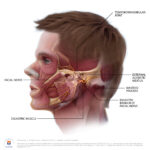
Temporomandibular disorders are a common cause of pain of non-dental origin in the oro-facial area (Dental Elf – 3rd Feb 2021). Previous studies and review have suggested a positive impact of manual therapy on temporomandibular disorders. This review looks specifically at manual therapy applied to the craniomandibular structures (cranio-mandibular manual therapy).
The aim of this review was to evaluate the effectiveness of cranio-mandibular manual therapy (CMMT) on pain and maximum mouth opening in people with temporomandibular disorders (TMD).
Methods
The review was registered in the PROSPERO databases and the protocol published (Asquini et al Mar 2021). Searches were conducted in the Medline/PubMed, Embase, Scopus, Web of Science, CINAHL , PEDro, ZETOC, Cochrane Library and Best Evidence, Index to Chiropractic Literature ChiroACCESS , Google Scholar, British National Bibliography and EthOS databases. Handsearching was conducted in the journals, Journal of Oral Rehabilitation, Musculoskeletal Science and Practice, The Journal of Oral & Facial Pain and Headache, Journal of Manual and Manipulative Therapy, Journal of Applied Oral Science. Randomised controlled trials (RCTs) examining CMMT alone vs comparison groups not including CMMT were considered. Two reviewers independently screened and selected studies and extracted data. Risk of bias was assessed using the Cochrane risk of bias tool (RoB 2). Data on pain and maximum mouth opening (MMO) were reported as mean difference (MD) and 95% confidence intervals (CI). The overall certainty of the evidence was evaluated using the Grading of Recommendations, Assessment, Development and Evaluations (GRADE).
Results
- 6 studies involving a total of 293 were included.
- 3 studies were conducted in Australia, 2 in Brazil and 1 in Poland.
- Comparators varies across the studies (sham treatment, control group, self-care and exercise, splint, kinesio tape and photobiomodulation therapy).
- 1 study was at high risk of bias 1ith 5 showing some concerns.
- All of the included studies showed a significant improvement in pain and MMO following CMMT in the mid-term, but only two showed the superiority of CMMT compared to other intervention
- The overall GRADE assessment of the evidence was very low.
Conclusions
The authors concluded: –
….very low quality of evidence supports CMMT for patients with TMD for successfully reducing pain and improving MMO in the mid-term. Whether CMMT is superior to other interventions remains unclear. Clinicians planning treatment of patients with TMD may consider CMMT, in addition to other treatment modalities, as one effective, low-cost, conservative option to manage pain and improve MMO in the mid-term.
Comments
The protocol for this review was published (Asquini et al. Mar. 2021) and registered on PROSPERO. An extensive database search was undertaken which was supplemented by handsearching of a number of relevant journals. However only a small number of studies met the inclusion criteria. Previously we looked at another review of manual therapy for TMD by Calixtre et al (Dental Elf – 1st July 2015) that included studies where the manual therapy involved structures other than craniomandibular structures (e.g. cervical spine and neck). Consequently, only two studies were common to both reviews with the Calixtre review included 8 studies compare to the 6 of the current review. While both reviews found that the manual therapy approach reduced pain and improved MMO there are important concerns regarding the quality of the evidence. There are few RCTs that address the effectiveness of MT techniques for TMD, and they are of low to very low quality. High quality RCTs of appropriate size and duration are needed that are conducted in line with SPIRIT statement and reported in line with the CONSORT statement are needed to improve the evidence in this area.
Links
Primary Paper
Asquini G, Pitance L, Michelotti A, Falla D. Effectiveness of manual therapy applied to craniomandibular structures in temporomandibular disorders: A systematic review. J Oral Rehabil. 2021 Dec 20. doi: 10.1111/joor.13299. Epub ahead of print. PMID: 34931336.
Other references
Asquini G, Rushton A, Pitance L, Heneghan N, Falla D. The effectiveness of manual therapy applied to craniomandibular structures in the treatment of temporomandibular disorders: protocol for a systematic review. Syst Rev. 2021 Mar 8;10(1):70. doi: 10.1186/s13643-021-01623-7. PMID: 33685496; PMCID: PMC7941703.
Dental Elf – 3rd Feb 2021
Dental Elf – 1st July 2015
Picture Credits
“Head Anatomy TMJ WITH Labels by Annie Campbell” by dundeetilt is licensed under CC BY-SA 3.0
